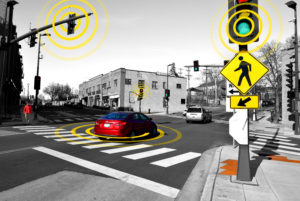You’ve probably heard a lot about autonomous vehicles, but how much do you know about connected vehicle (CV) technology and how it will help us be safer drivers? I learned quite a bit recently about this evolving technology. In short, CV technology allows vehicles to communicate with other vehicles, traffic signals, crosswalks and more. This wireless communication, known as CV technology, is being used to relieve congestion, reduce the number of traffic collisions and save lives. Two U.S. cities in particular, Marysville, Ohio and Tampa, Florida, are using connected vehicle (CV) technology in some interesting ways to improve traffic safety.
 Smart Intersections
Smart Intersections
The city of Marysville, Ohio, has implemented CV technology to become the first fully-connected city in the world. Maryville’s 27 traffic signals now have the ability to communicate with connected vehicles. A “smart intersection” that uses sensors and cameras to send safety messages to drivers was implemented at Main Street and Fifth Street in the Marysville downtown area. See for yourself how this “smart intersection” helps drivers avoid collisions.
Connected Vehicle Pilot
At the time of the ITS conference the city of Tampa, Florida, was working on a CV pilot to alleviate traffic congestion on the expressway during peak commute times. The pilot was unique because Tampa was one of only three sites selected by the U.S. Department of Transportation, and it was one of the first CV pilot projects in the U.S. where resident volunteers drove their own cars. Equipped with CV technology (vehicle, pedestrian and traffic signal sensors), drivers receive various warnings if problems are detected, such as a pedestrian crossing, a vehicle slowing ahead, or a wrong way driver. Buses and streetcars were also part of the pilot project. Check out this video about the CV pilot by the Tampa Hillsborough Expressway Authority (THEA) and its partners.
Keep your eyes open for new developments in connected vehicle technology!
